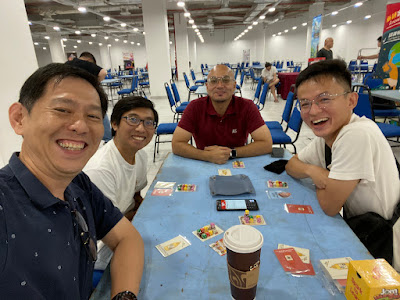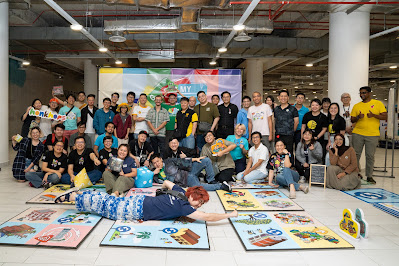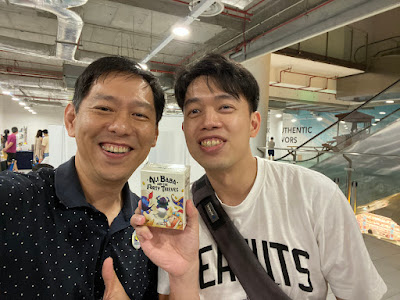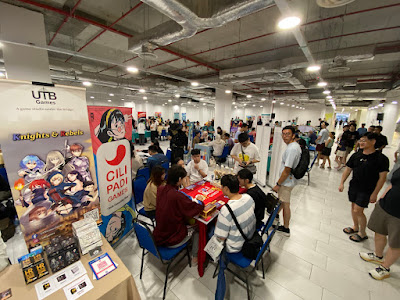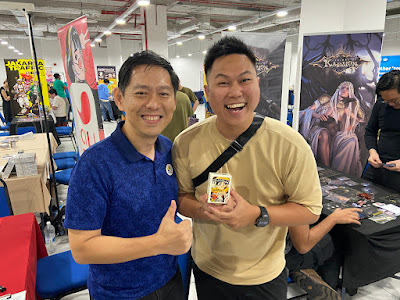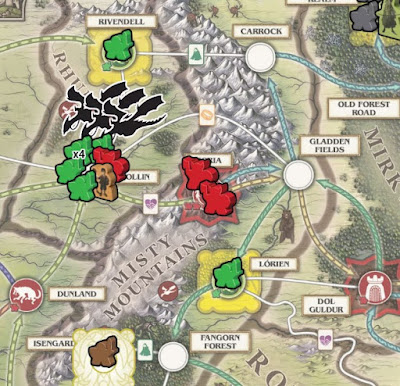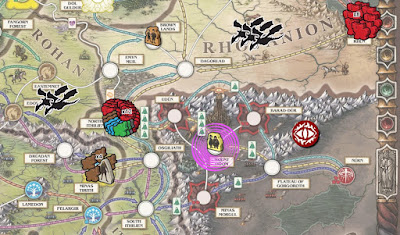The Asian Board Games Festival (Malaysia) was held at 1st Avenue Mall, Penang,
on 11 - 13 Jul 2025. This was the second time this event was run. I was there
last year too. This year it was held over three days, Friday to Sunday,
compared to just two days in 2024. This meant more stamina needed. Elder
daughter Shee Yun went with me last year to help out, but mostly I did the
demos and game teaching. This year she didn't join me, and I looked for local
assistants through the organisers.
Four of us travelled together from Kuala Lumpur to Penang - Jon, Nick,
Buddhima and I. This was our fresh and energetic "before" shot. We took it so
that we could compare it with an "after" shot at the end of the event.
The event started on Friday, and by Wednesday the tables and chairs had been
set up. Exhibitors could start preparing on Thursday. We arrived Thursday
afternoon. The event space this year was much larger than last year. The event
was held on Ground Floor and First Floor in 2024. This year it was all in one
single larger area on Second Floor.
After doing our setup, we took the opportunity to play some games. This
is Jom Burger, the latest game from Specky Studios. This is a
light dice drafting game.
Hiro is a designer and publisher from Kyoto, Japan. We had connected on
Facebook some time ago, but this was the first time we met in person. I tried
his new game Olenon and was really impressed with the design. I
immediately bought a copy and also asked for an autograph.
Friday morning and ready to roll! (still at full batt)
This time I had my own little wooden display rack
Helmer (left) is a gamer from Norway. He read my blog on
BoardGameGeek.com and my upcoming
game
Malaysian Holidays caught his attention. That was how we got
connected. This was the first time we met in person. He is an expert in Asian
culture and history, including holidays and celebrations.
Giant Trishaw Frenzy
Pinocchio's first public play after launch
My cousin Jackson lives in Penang and came to support me.
My booth stamp this year featured Pinocchio
“If you lie, you die!”
Group photo Friday evening (courtesy Kee Sit)
Saturday (Day 2) morning and we were already showing some wear and tear
Ali Baba and the Forty Thieves was published last year after ABGF, so
it wasn't at ABGF 2024. This year was its first ABGF too alongside
Pinocchio. However quite a few visitors had already played
Ali Baba because I had distributed it to Penang through
retailers.
The booth of Meja Belakang - one of the most successful Malaysian
publishers
Pinocchio in play
This group wanted to play Pinocchio but I still had another group
at my booth. I hunted around for an unoccupied table so that I could teach
them to play while my assistant taught the other group at my booth. That's why
the tablecloth is not red. I use red as my brand colour.
Thank you for your support! Quite a few visitors told me they had already
played Ali Baba before and that they liked the game. That was
nice.
A group of six playing Pinocchio. Pinocchio plays 3 to 7
players. Later this group moved on to play
Snow White and the Eleven Dwarfs. When I show people
Snow White at conventions, the first reaction is often "how do you
get such a game played at a convention?" However I do usually get it played
despite the minimum player count of seven. People are attracted by the art,
and they come ask whether they can play. When they don't have enough players
in the group, I ask them to go grab strangers to play with them, or I try to
grab other people passing by. Most of the time we manage to assemble
seven.
I taught Dancing Queen to this publisher team from Indonesia - Whatt
Play
I knew Gazelle through a business community. Prior to this we were only
connected online. She lives in Penang and came to visit, and this was the
first time we met in person.
We had our lunch + dinner at 11pm, after the end of Day 2
Sunday (Day 3) we had dimsum / yumcha before showtime
Freddie of Ludus / Larong Atin is an industry veteran in the Philippines. I
asked for his help to give me feedback on my games Dancing Queen and
Pinocchio, in particular whether they would be a good fit for the
market in the Philippines. He also bought some stock of
Ali Baba and the Forty Thieves and Pinocchio to sell in the
Philippines, to test the market. Friends in Philippines if you are interest in
either of these game titles do reach out to them.
The biggest gain for me this trip was getting to know many industry players
from other countries in Asia, especially South East Asia. I learned a lot from
speaking to them, and that's something money can't buy.
Heng Hee's Papermade Duel made an appearance
Sunday was a very busy day. My booth sales was better than the previous two
days.
This year I engaged several helpers for my booth, so I had the opportunity to
go try the games at other booths. Last year I was 100% stuck at my own booth
and I didn't get to play other people's games. This year I was able to meet
many more people and have good conversations. Getting decent sales is good,
but more important is the publicity, marketing, networking, exploring
collaborations and opportunities, and learning from others.
Ali Baba and the Forty Thieves
Over the three days, my booth was almost always fully occupied except for Day
1, which was Friday and a work day. I was lucky to get a booth right at the
front. I had a very visible spot.
BGN from Thailand had a giant poster
Thank you for supporting my game!
At the end of Day 3 I had a game exchange with Play Logue from Singapore
It always makes me happy to see a happy customer, and dayum he looks 5x
happier than I am
Nicholas was of the helpers who assisted me at my booth
Tom (
小东老师的卓游乐园) from Taiwan brought many fun party games and also showcased a few small and
clever abstract games. After trying
Coco Boom (爆爆椰) and having
a blast I bought a copy. I'll write more about it later.
Behind the scenes: packing up after 10pm on Sunday
Movers at work
We still looked full of energy, but actually we were all exhausted. I only had
3 or 4 hours of sleep every day. However it was great working together with
friends who share the same passion and mission.
Just to be a show-off, I quickly made this Instagram post after the event. I
should have brought more copies. I was pleasantly surprised when Note from
Wisebox (Thailand) told me that Snow White is being sought after in
Thailand, and he wanted to buy all the copies I had with me in Penang.



